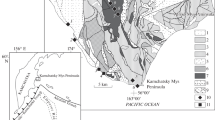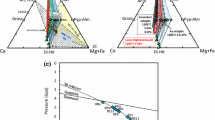Summary
At its southernmost end, the main spreading centre of the North Fiji Basin is propagating into arc crust of the poorly-known Hunter Ridge. We define nine magmatic groups from major element glass chemistry and olivine and spinel compositions in samples dredged from twenty six sites in this area by the “R/V Academician A. Nesmeyanov” in 1990. These include groups of boninites, island arc tholeiites (IAT), mid-ocean ridge basalts (MORB), enriched mid-ocean ridge basalts (E-MORB), olivine porphyritic andesites and basaltic andesite and Na-rhyolites. Primitive lavas containing highly forsteritic olivine phenocrysts are common in all the groups, except for the rhyolites.
We report over 100 glass analyses for dredged rocks from this region, and about 300 olivine-spinel pairs for representatives of all the magmatic groups identified, except the Na-rhyolites.
The MORB in this region are probably produced at the propagating spreading centre in the southern part of the North Fiji Basin. Juxtaposition of shallow, hot MORB-source diapirs supplying the MORB in this area, and the sub-arc damp, refractory upper mantle beneath the Hunter Ridge, provides suitable petrogenetic conditions to produce a range of magma types, from island arc tholeiites through to high-Ca boninites. The latter were recovered in eleven dredges.
The E-MORB lavas recovered from the extreme southern margin of the North Fiji Basin are shown to be essentially identical to those dredged from adjacent older South Fiji Basin crust. It is hypothesized that the former were either scraped off the South Fiji Basin crust during an episode of oblique subduction that may have generated the Hunter Ridge during the last 5 Myr, or alternatively, that slices of the South Fiji Basin crust were trapped and incorporated into the North Fiji Basin as the subduction zones fronting the Vanuatu arc stepped or propagated southward.
Zusammenfassung
Das spreading centre des Nord-Fidschi-Beckens setzt sich an seinem südlichsten Ende in die Inselbogen-Kruste des noch wenig bekannten Hunter-Rückens fort.
Wir definieren 9 magmatische Gruppen auf der Basis der Hauptelement-Zusammensetzung von Gläsern und der Zusammensetzung von Olivin und Spinell in Proben die das Forschungsschiff R/V Akademiker A. Nesmeyanov von 26 Stellen im Jahr 1990 aufgesammelt hat. Zu diesen gehören Gruppen von Boniniten, Inselbogentholeiiten (IAT), Basalten zentralozeanischer Rücken (MORB), angereicherte zentralozeanische Rücken (E-MORB), Olivin-porphyritische Andesite und basaltische Andesite, sowie Na-Rhyolite. Primitive Laven mit Olivinkristallen, die reich an Forsterit-Komponenten sind, kommen in allen diesen Gruppen, mit Ausnahme der Rhyolite, vor.
Wir legen über 100 Glas-Analysen von Gesteinen aus diesem Gebiet vor und über 300 Olivin-Spinell-Paare für Vertreter aller der hier identifizierten magmatischen Gruppen, mit Ausnahme der Natriumrhyolite.
Die MORB in diesem Gebiet sind wahrscheinlich an dem aktiven Spreading Center im Südteil des Nord-Fidschi-Beckens entstanden. Das nebeneinander Vorkommen von seichten heißen MORB-Quellen Diapiren, die MORB in diesem Gebiet erzeugen, und der Sub-Inselbogen, wasserhaltige, refraktäre obere Mantel unter dem Hunter Rücken führen zu geeigneten petrogenetischen Bedingungen für die Entstehung einer Vielfalt von Magmatypen, von Inselbogentholeiiten bis zu sehr Kalziumreichen Boniniten. Die letzteren wurden in 11 Dredge-Proben gefunden.
Die E-MORS Laven, die aus dem extremen Südteil des Nord-Fidschi-Beckens entnommen wurden, sind im wesentlichen mit jenen identisch, die aus der benachbarten älteren Kruste des Süd-Fidschi-Beckens stammen. Es wird vermutet, daß die letzteren entweder aus dem Süd-Fidschi-Becken während einer Episode obliger Subduktion, die in den letzten 5 Millionen Jahren zur Entstehung des Hunter Ridge geführt hat, abgeschert wurden, oder auch daß Teile der Kruste des Süd-Fidschi-Beckens in das Nord-Fidschi-Becken inkorporiert wurden als Subduktionszonen gegenüber dem Vanuato-Bogen sich nach Süden fortbewegten.
Similar content being viewed by others
References
Arai S (1987) An estimation of the least depleted spinel peridotite on the basis of olivinespinel mantle array. N Jb Miner Mh 8: 347–354
Auzende JM, Eissen JP, Lafoy Y, Gente P, Charlou JL (1988a) Seafloor spreading in the North Fiji Basin (Southwest Pacific). Tectonophysics 146: 317–351
Auzende JM, Lafoy Y, Marsset B (1988b) Recent geodynamic evolution of the North Fiji Basin (southwest Pacific). Geology 16: 925–989
Barsdell M (1988) Petrology and petrogenesis of clinopyroxene-rich tholeiitic lavas, Merelava volcano, Vanuatu. J Petrol 29: 927–964
Barsdell M, Berry RF (1990) The petrology and geochemistry of Western Epi. J Petrol 31: 747–777
Bryan WB (1979) Low-K dacites from the Tonga-Kermadec island arc: petrography, chemistry, and petrogenesis. In:Barker F (ed) Trondhjemites, dacites and related volcanic rocks. Elsevier, Amsterdam, pp 581–601
Coish RA, Hickey R, Frey FA (1982) Rare earth element geochemistry of the Betts Cove ophiolite, Newfoundland: complexities in ophiolite formation. Geochim Cosmochim Acta 46: 2117–2134
Coleman RG, Peterman ZE (1975) Oceanic plagiogranite. J Geophys Res 80: 1099–1108
Crawford AJ, Falloon TJ, Green DH (1989) Classification, petrogenesis and tectonic setting of boninites. In:Crawford AJ, (ed) Boninites and related rocks. Unwin Hyman, London, pp 1–49
Dick HJB, Bullen T (1984) Chromian spinel as a petrogenetic indicator in abyssal and alpine-type peridotites and spatially associated lavas. Contrib Mineral Petrol 86: 54–76
Dixon S, Rutherford MJ (1979) Plagiogranites as late stage immiscible liquids in ophiolite and mid-ocean ridge suites: an experimental study. Earth Planet Sci Lett 45: 45–60
Dmitriev L V, Sobolev AV, Suschevskaya NM, Zapunny SA (1985) Abyssal glasses, petrologic mapping of the oceanic floor and “geochemical leg” 82. In:Bougault H, Cande SC et al (eds) Init Repts, DSDP, 82: Washington (U.S. Govt Printing Office), 509–518
Dubois J, Launay J, Recy J (1977) New Hebrides trench: subduction rate from associated lithospheric bulge. Can J Earth Sci 14: 250–255
Dupuy C, Dostal J, Marcelot G, Bougault H, Joron JL, Treuil M (1982) Geochemistry of basalts from central and southern New Hebrides arc: implication for their source rock composition. Earth Planet Sci Lett 60: 207–225
Eissen J-P, Lefévre C, Maillet P, Morvan G, Nohara M (1991) Petrology and geochemistry of the central North Fiji Basin spreading center (Southwest Pacific) between 16°S and 22°S. Marine Geology 98: 201–239
Ewart A (1976) Mineralogy and chemistry of modern orogenic lavas—some statistics and implications. Earth Planet Sci Lett 31: 417–432
Ewart A (1979) A review of the mineralogy and chemistry of Tertiary-Recent dacitic, rhyolitic, and related salic volcanic rocks. In:Barker F (ed) Trondhjemites, dacites and related volcanic rocks. Elsevier, Amsterdam, pp 13–21
Fryer P, Sinton JM, Philpotts JA (1981) Basaltic glasses from the Mariana trough. In:Hussong DM, Uyeda S et al, (eds) Init Repts DSDP 60; Washington (U.S. Govt. Printing Office) 601–609
Fryer P, Taylor B, Langmuir CH, Hochstaedter AG (1990) Petrology and geochemistry of lavas from Sumisu and Torishima backarc rifts.. Earth Planet Sci Lett 1O0: 161–178
Gerlach DC, Leemun WP, Avé HG (1981) Petrology and goechemistry of plagiogranite in the Canyon Mountain Ophiolite, Oregon. Contrib Mineral Petrol 77: 82–92
Gorton MP (1977) The geochemistry and origin of Quaternary volcanism in the New Hebrides. Geochim Cosmochim Acta 41: 1257-l270
Hamburger MW,Isacks BL (1987) Deep earthquakes in the South Pacific: A tectonic interpretation. J Geophys Res 92: 3841–13854
Hochstaedler AG,Gill JB,Kusakabe M,Newman S,Pringle M,Taylor B,Fryer P (1990a) Volcanism in the Sumisu Rift, I. Major element, volatile, and stable isotope geochemistry. Earth Planet Sci Lett 100: 179–194
Hochstaedler AG,Gill JG,Morris JD (1990b) Volcanism in the Sumisu Rift, II. Subduction and non-subduction related components. Earth Planet Sci Lett 100: 195–209
fIkeda Y, Yuasa M (1989) Volcanism in the nascent back-arc basin behind the Shichito Ridge and adjacent areas in the Izu-Ogazawara arc, northwest Pacific: evidence for mixing between E-type MORB and island are magmas at the initiation of back-arc rifting. Contrib Mineral Petrol 101: 377–393
Ishizuka H, Kawanabe Y, Skai H (1990) Petrology and geochemistry of volcanic rocks dredged from the Okinawa Trough, an active back arc basin Geochemical Journal 24: 75–92
Jakes P, Gill J (1970) Rare earth elements and the island tholeiitic series. Earth Planet Sci Lett 9 17–28
Jarosewich EJ, Nelen JA, Norberg JA (1980) Reference samples for electron microprobe analysis. Geostandards Newsletter 4: 43–47
Johnson kTM, Sinton JM (1990)Petrology,tectonic setting,and the formation of back-arc basin basalt in the North Fiji Basin. Geol Jb D92: 517–545
Jureweiz AJG, Watson EB (1988) Cations in olivine, Part 1: calcium partitioning and calcium-magnesium distribution between olivines and coexisting melts, with petrologic applications. Contrib Mineral Petrol 99: 176–185
Lavrentev YG, Pospelova LN, Sobolev NV (1974) Rock-forming mineral compositions determination by X-ray microanalysis. Zavodskaya Laboratoria 40: 657–666 (in Russian)
Maillet P,Monzier M,Lefevre C (1986) Petrology of Matthew and Hunter volcanoes, south New Hebrides island arc(Southwest Pacific). J Volcanol Goetherm Res 30:1–27
Maillet P, Monzier M, Eissen J-P, Louat R (1989) Geodynamics of an arc-ridge junction: the case of the New Hebrides Arc/North Fiji Basin. Tectonophysics 165: 251–268
Miyashiro A (1974) Volcanic rock series in island arcs and active continental margin. Am. Journal Sci. 274: 321–355
Monzier M, Maillet P, Foyo Herrera J, Louat R, Misegue F, Pontoise B (1984 The termination of the southern New Hebrides subduction zone (southwestern Pacific). Tectonophysics 101:177–184
Monzier M, Danyushevsky LV, Crawford AJ, Bellon H, Cotten J (1992) High-Mg andesites from the southern termination of the New Hebrides island arc(SW Pacific). J Volcanol Geotherm Res (submitted)
Pearcy LG, DeBari SM, Sleep NH (1990) Mass balance calculations for two sections of island arc crust and implication for the formation of continents. Earth Planet Sci Lett 96: 427–442
Price RC, Johnson LE, Crawford AJ (1990) Basalts of the North Fiji Basin: the generation of back arc basin magmas by mixing of depleted and enriched mantle sources. Contrib Mineral Petrol 105: 106–121
Sigurdsson H, Schilling JG (1976) Spinels in Mid-Atlantic Ridge basalts: chemistry and occurrence. Earth Planet Sci Lett 29: 7–20
Simkin T, Smith JV (1970) Minor-element distribution in olivines. J Geology 78: 304–325
Sinton JM, Johnson KTM, Price RC, Staudigel H, Zindler A (1991) Petrology and geochemistry of submarine lavas from the Lau and North Fiji back-arc basins. In:Kroenke LW Eade JV (eds) Basin formation ridge crest processes, and metallogenesis in the North Fiji Basin. (Circum-Pacific Council for Energy and Mineral Resources, Earth Science series, 3) 12: 155–177
Stormer JC (1973) Calcium zoning in olivine and its relationship to silica activity and pressure. Geochim Cosmochim Acta 37: 1815–1821
Sun SS, McDonough WF (1989) Chemical and isotopic systematics of oceanic basalts: implications for mantle composition and processes. In:Saunders AD, Norry MJ (eds) Magmatism in the ocean basins. Geological Society Special Pub 42: 313–345
Author information
Authors and Affiliations
Rights and permissions
About this article
Cite this article
Sigurdsson, I.A., Kamenetsky, V.S., Crawford, A.J. et al. Primitive island arc and oceanic lavas from the hunter ridge-hunter fracture zone. Evidence from glass, olivine and spinel compositions. Mineralogy and Petrology 47, 149–169 (1993). https://doi.org/10.1007/BF01161564
Received:
Accepted:
Issue Date:
DOI: https://doi.org/10.1007/BF01161564




